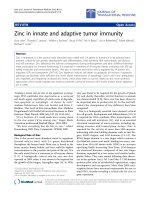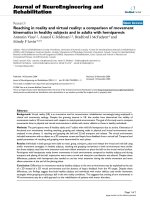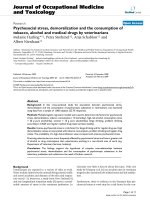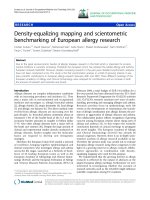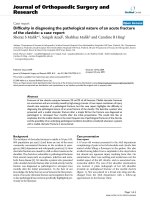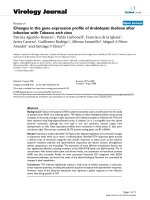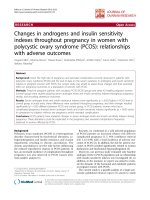Báo cáo hóa học: " Improvement in dielectric and mechanical performance of CaCu3.1Ti4O12.1 by addition of Al2O3 nanoparticles" pot
Bạn đang xem bản rút gọn của tài liệu. Xem và tải ngay bản đầy đủ của tài liệu tại đây (888.69 KB, 13 trang )
This Provisional PDF corresponds to the article as it appeared upon acceptance. Fully formatted
PDF and full text (HTML) versions will be made available soon.
Improvement in dielectric and mechanical performance of CaCu3.1Ti4O12.1 by
addition of Al2O3 nanoparticles
Nanoscale Research Letters 2012, 7:68 doi:10.1186/1556-276X-7-68
Chompoonuch Puchmark ()
Gobwute Rujijanagul ()
ISSN 1556-276X
Article type Nano Review
Submission date 19 September 2011
Acceptance date 5 January 2012
Publication date 5 January 2012
Article URL />This peer-reviewed article was published immediately upon acceptance. It can be downloaded,
printed and distributed freely for any purposes (see copyright notice below).
Articles in Nanoscale Research Letters are listed in PubMed and archived at PubMed Central.
For information about publishing your research in Nanoscale Research Letters go to
/>For information about other SpringerOpen publications go to
Nanoscale Research Letters
© 2012 Puchmark and Rujijanagul ; licensee Springer.
This is an open access article distributed under the terms of the Creative Commons Attribution License ( />which permits unrestricted use, distribution, and reproduction in any medium, provided the original work is properly cited.
1
Improvement in dielectric and mechanical performance of CaCu
3.1
Ti
4
O
12.1
by addition
of Al
2
O
3
nanoparticles
Chompoonuch Puchmark
1
and Gobwute Rujijanagul*
2
1
Department of Physics, Faculty of Science, Naresuan University, Phitsanulok, 65000,
Thailand
2
Department of Physics and Materials Science, Faculty of Science, Chiang Mai University,
Chiang Mai, 50200, Thailand
*Corresponding author:
Email addresses:
CP:
GR:
Abstract
The properties of CaCu
3.1
Ti
4
O
12.1
[CC3.1TO] ceramics with the addition of Al
2
O
3
nanoparticles, prepared via a solid-state reaction technique, were investigated. The
nanoparticle additive was found to inhibit grain growth with the average grain size decreasing
from approximately 7.5 µm for CC3.1TO to approximately 2.0 µm for the unmodified
samples, while the Knoop hardness value was found to improve with a maximum value of 9.8
GPa for the 1 vol.% Al
2
O
3
sample. A very high dielectric constant > 60,000 with a low loss
tangent (approximately 0.09) was observed for the 0.5 vol.% Al
2
O
3
sample at 1 kHz and at
room temperature. These data suggest that nanocomposites have a great potential for
dielectric applications.
Keywords: nanocomposites; dielectric properties; microstructure; mechanical property.
Background
CaCu
3
Ti
4
O
12
[CCTO] is an interesting dielectric material which exhibits a high dielectric
constant over 10,000 at room temperature and shows temperature independence over the
temperature range from approximately 100 to 400 K [1-3]. Since the discovery of this
material by Subramanian et al. [1], CCTO has been widely studied to further understand and
improve its properties. The CCTO crystal has a cubic symmetry with an Im3 space group. In
the CCTO lattice, the TiO
6
octahedra are tilted which results in a doubling of the perovskite-
like structure, involved in the planar square arrangement of the oxygen around the copper
ions [4]. The CCTO ceramics exhibit an electrically heterogeneous structure involving
mobile-charged species in terms of the Maxwell-Wagner relaxation [5]. Internal interfaces in
the polycrystalline CCTO give rise to the polarization in the insulating grain boundary and at
the semiconducting grains which is well explained by the internal barrier layer capacitor
[IBLC] model [6, 7]. To improve the dielectric properties further, many cations have been
introduced into CCTO, including Co, Zr, Fe, Sc, and Nb on the B site and substitution of La
and Eu at the A site [4, 8-12]. Although some of these additives resulted in a reduction of the
loss tangent, most additives also reduced the dielectric constant. Fang et al. proposed that Cu
stoichiometry can affect the electrical properties of the CCTO ceramics, [13] while Kwon et
2
al. reported that both Cu- and Ti-deficient CCTO presented a higher dielectric constant than
undoped CCTO [14]. Recently, many authors have reported on the properties of composites
between CCTO and other materials such as BaTiO
3
, SrTiO
3
, ZnNb
2
O
6
, and polystyrene [15-
17]. However, the properties of composites formed by adding nanocomposites to CCTO have
still not been widely investigated. In the present work, a new nanocomposite system between
CCTO (with non-stoichiometric composition) and Al
2
O
3
nanoparticles was fabricated. We
demonstrate that the dielectric behavior of the composites can be significantly improved by
the addition of these nanoparticles. Some other properties of the nanocomposites were also
investigated and reported.
Experimental procedure
It has been proposed that Cu stoichiometry is related to the dielectric response [13, 14]. Fang
et al. [13] reported that Cu-excessive CCTO samples showed improved densification and
dielectric behaviors. In the present work, Cu-excessive CCTO ceramics in a composition of
CaCu
3.1
Ti
4
O
12.1
[CC3.1TO] were fabricated. Our studies indicate that this composition
exhibited a good densification and dielectric response (data not shown). The samples were
fabricated using the solid-state mixed oxide method. Reagent grade CaCO
3
, CuO, and TiO
2
powders were used as starting materials. The mixture of these powders was ground for 24 h
in ethanol using zirconia grinding media. The suspension was then dried and subsequently
calcined at 900°C for 8 h with a heating rate of 5 °C/min. The calcined CC3.1TO powders
were mixed with (0.5, 1, and 2 vol.%) Al
2
O
3
nanoparticles (40 nm average particle size) and
1% polyvinyl alcohol [PVA] binder and were ball-milled in ethanol for 12 h using the same
method as mentioned earlier. The slurry was then dried and sieved to a fine powder. The
mixed powders were uniaxially pressed into pellets at a pressure of 60 MPa. The PVA binder
was burnt out at 550°C with a heating rate of 1°C/min. Finally, the pellets were sintered at
1,025°C for 6 h with a heating rate of 5°C/min. The sintered pellets were investigated for
phase formation by X-ray diffraction [XRD]. Density of the sintered samples was measured
using the Archimedes method with distilled water as the fluid medium. The microstructures
of the sintered samples were characterized using a scanning electron microscope [SEM], and
the average grain size was determined using the linear intercept method. For the electrical
measurement, silver paste was applied to both sides of the circular faces of the ceramics, then
dried at 600°C for 15 min, and cooled naturally to room temperature. The dielectric constant
and dielectric loss were then measured using a LCZ meter. The mechanical properties
(hardness) of various sintered samples were studied using a Knoop microhardness tester.
Indentations were applied to the polished surfaces with 0.3- and 0.5-kg loads and with an
indentation period of 15 s.
Results and discussion
Phase formation
The XRD results for the sintered ceramics containing up to 2 vol.% Al
2
O
3
are illustrated in
Figure 1. All of the patterns were similar to the unmodified CCTO diffraction peaks and were
consistent with the results reported previously [18]. The peaks of the second phases such as
Cu
2
O and CuO could not be observed in the XRD patterns [14]. Further, no peak was
observed for the Al
2
O
3
phase in any of the XRD patterns. This may be due to the amount of
Al
2
O
3
additive which was too little to be detected at the sensitivity level of the XRD
instrument.
3
Densification, microstructure, and hardness behavior
The plot of density as a function of Al
2
O
3
volume fraction is shown in Figure 2. The density
slightly increased with the increasing amounts of Al
2
O
3
up to 1 vol.% and then decreased for
the 2 vol.% sample. The reduction in density for the higher Al
2
O
3
samples suggests that the
sintering mechanism of the samples was not complete. To obtain the best densification for
compositions > 0.5 vol.% Al
2
O
3
, higher sintering temperatures or longer soaking times would
be required.
Figure 3 displays the SEM micrographs of the as-sintered surfaces of CC3.1TO-Al
2
O
3
nanocomposites. An agglomeration of Al
2
O
3
nanoparticles was not explicitly observed,
implying that the processing method produced a reasonably uniform distribution of the
nanoparticles in the matrix of the composites. The surfaces of the CC3.1TO samples showed
a duplex microstructure consisting of coarse grains (average grain size of approximately 20
µm) and fine grains (average grain size of approximately 1 µm) located around the coarse
grains. This characteristic indicates an abnormal grain growth in the microstructure of the
samples. The formation of a copper oxide liquid phase (in Cu-excessive CCTO), as suggested
by Kim et al. [19], may be the main reason for the formation of abnormal grain growth since
the present samples have a Cu-excessive CCTO composition. The liquid phase enhanced
nucleation of abnormal grains and the abnormal grains were then formed after sintering.
Similar results have been reported previously for Cu-excessive CCTO ceramics [14, 20]. The
average grain sizes of the coarse grains were found to decrease with the additive (e.g.,
average grain size of the coarse grains was approximately 3 µm for the 2 vol.% sample;
Figure 3b). However, the average grain size of the fine grains remained unchanged for higher
Al
2
O
3
content samples. Overall, the average grain size, calculated from coarse and fine
grains, decreased from approximately 7.5 µm for the unmodified sample to approximately 2.0
µm for the 2 vol.% sample (Figure 2). The decrease in the average grain size is most likely
caused by the mismatch of the different components. Further, Al
2
O
3
might segregate to the
grain boundaries which could prevent grain boundary movement during the sintering process
and, as a result, inhibit grain growth.
The Knoop hardness values of the samples as a function of Al
2
O
3
content are illustrated in the
inset of Figure 2. The Knoop hardness data reveal that the additive improved the hardness
values. The maximum hardness value in this work was 9.8 GPa (for the 1 vol.% sample)
which is comparable to the value reported by Puchmark et al. for the PZT-Al
2
O
3
nanocomposites. The improvement in the mechanical properties is most likely due to the
nanoparticles reinforcing the grain boundaries and acting as effective pins against microcrack
propagation [21]. Moreover, the enhancement of hardness can be related to the reduction in
grain size, i.e., small grain size samples gave a higher measured hardness.
Dielectric properties
Figure 4 shows the dielectric constants versus the frequency at room temperature for the
CC3.1TO and CC3.1TO-Al
2
O
3
pellets. Compared with the CC3.1TO sample, a significant
improvement in the dielectric constant of the CC3.1TO-Al
2
O
3
samples was observed. For the
CC3.1TO sample, the dielectric constant was 11,000 (measured at 1 kHz and at room
temperature) which is close to the values reported previously [1, 2]. The CC3.1TO sample
also exhibited nearly dielectric-frequency independence over the frequency range of 0.1 to
500 kHz. Further, the dielectric constant increased reaching a value > 60,000 at 1 kHz for the
0.5 vol.% sample then decreased for further increases in the Al
2
O
3
content. For the 2 vol.%
4
sample, however, the dielectric-frequency curve showed a weak frequency dispersion of the
dielectric constant. The reduction in the dielectric constant for the samples which were doped
with more than 0.5 vol.% Al
2
O
3
may be due to the fact that composites with higher additive
amounts (Al
2
O
3
> 0.5 vol.%) also had higher structural heterogeneity. Moreover, the
formation of an impurity phase may have caused a reaction between Al
2
O
3
and CC3.1TO
which could not be detected using the XRD technique [22], but it might also have contributed
to the reduction in the dielectric constant. Plots of the loss tangent versus the frequency of the
CC3.1TO and CC3.1TO-Al
2
O
3
pellets at room temperature are presented in the inset of
Figure 4. The loss tangent-frequency curve of the CC3.1TO ceramic exhibited a weak
frequency dispersion for a narrow frequency range (1 to 50 kHz). However, after adding the
additive, the loss tangent significantly decreased at low frequencies (<1 kHz) which resulted
in a wider range of frequency stability (10 Hz to 10 kHz). Further, the loss tangent decreased
from 0.21 for the CC3.1TO ceramics to 0.09 for the 0.5 vol.% sample (at 1 kHz). A further
slight decrease in the loss tangent was observed for additional additive amounts. The decrease
in loss tangent shows a reduced conductivity of the CC3.1TO-Al
2
O
3
samples. This result
could be related to changes in the transport behavior due to an increase in resistivity at the
grain boundaries where the additive nanoparticles predominantly segregated.
Figure 5 shows the dielectric constant values as a function of temperature at various
frequencies for the CC3.1TO and CC3.1TO-Al
2
O
3
pellets. The CC3.1TO sample showed a
high dielectric constant (
ε
r
approximately 10,000) with temperature and frequency stability
from room temperature to 60°C. After adding the additive, however, a significant
improvement in the dielectric behavior was observed. The 0.5 vol.% sample showed a very
high dielectric constant > 60,000 (at 1 kHz) which was nearly temperature-independent for
the temperature range of approximately 35°C to 110°C. Compared to the CC3.1TO sample,
this sample also displayed a pronounced frequency dependence of the dielectric constant
especially for temperatures < 125°C. Moreover, the dielectric-temperature curve of the 0.5
vol.% presented a broad flat curve at high frequencies (>10 kHz). For higher additive
amounts (Al
2
O
3
> 0.5 vol.%), the dielectric constant decreased with the increasing additives.
Further, the dielectric frequency dispersion for the Al
2
O
3
nanoparticle sample with 2 vol.%
was not as strong for temperatures < 112°C. The loss tangent values as a function of
temperature at various frequencies for the samples are illustrated in the insets of Figure 5. For
the CC3.1TO sample, the loss tangent value was 0.21 and was stable with temperature as well
as frequency from room temperature to approximately 41°C. The 0.5 vol.% sample had a loss
tangent value lower than 0.10 for room temperature to approximately 50°C. From the (IBLC)
model, the apparent dielectric constant (
r
ε
′
) can be related to the microstructure parameters
by the formula [23]:
gb
r
d
t
ε ε
′
=
, (1)
where d is the grain size, t is the thickness of the grain boundary (barrier width), and
gb
ε
is
the internal dielectric constant of the barrier material. Since the grain size of the present
samples decreased with the increasing additive, Equation 1 predicts that the higher dielectric
constant for the 0.5 vol.% sample is not related to the grain size, but it may be connected to a
change in the grain boundary characteristics such as
gb
ε
and t after adding the additive. The
reason for the change of grain boundary characteristic is still unclear, but it is possible that
the Al
2
O
3
nanoparticles had a reaction with the matrix of the CC3.1TO, and as a result, the
formation of Al-metal oxide phases at the grain boundary produced other products in small
5
amounts which could not be detect by XRD [22]. However, the higher density for the 0.5
vol.% sample can be explained by the observed higher dielectric constant in the present work.
Conclusions
CC3.1TO-Al
2
O
3
nanocomposites were fabricated for the first time. The samples were
prepared using a solid-state reaction. The CC3.1TO ceramics showed a duplex
microstructure, consisting of coarse and fine grains, while the nanocomposites showed
mainly fine grains in their microstructure due to the fact that the additive inhibited grain
growth. The additive also enhanced the hardness value especially for the 1 vol.% sample.
However, the CC3.1TO and 0.5 vol.% Al
2
O
3
showed a high dielectric constant with a strong
dielectric frequency dispersion especially at low temperatures and also had a lowered loss
tangent value, as compared with other samples. These results indicate that the addition of
nanoparticles may be an alternative method to improve the dielectric behavior in some other
giant dielectric materials.
Competing interests
The authors declare that they have no competing interests.
Authors' contributions
CP carried out the fabrication of CC3.1TO, XRD characterization, SEM characterization,
density measurement, grain size measurement, dielectric properties measurement, and Knoop
hardness measurement. GR designed the whole experimental procedure and related analyses.
All authors read and approved the final manuscript.
Acknowledgments
This work was supported by The Thailand Research Fund (TRF), Thailand's Office of the
Higher Education Commission (OHEC), and Faculty of Science and Graduate School,
Chiang Mai University. The authors would like to thank Prof. Dr. Tawee Tunkasiri for his
help in many facilities.
References
1. Subramanian MA, Li D, Duran N, Reisner BA, Sleight AW: High dielectric constant in
ACu
3
Ti
4
O
12
and ACu
3
Ti
3
FeO
12
phases. J Solid State Chem 2000, 151:323-325.
2. Ramirez AP, Subramanian MA, Gardel M, Blumberg G, Li D, Vogt T, Shapiro SM: Giant
dielectric constant response in a copper-titanate. Solid State Commun 2000, 115:217-
220.
3. Homes CC, Vogt T, Shapiro SM, Wakimoto S, Ramirez AP: Optical response of high-
dielectric-constant perovskite-related oxide. Science 2001, 293:673-676.
6
4. Leret P, Fernandez JF, Frutos J de, Fernandez-Hevia D: Nonlinear I–V electrical
behaviour of doped CaCu
3
Ti
4
O
12
ceramics. J Eur Ceram Soc 2007, 27:3901-3905.
5. Lunkenheimer P, Bobnar V, Pronin AV, Ritus AI, Volkov AA, Loidl A: Origin of
apparent colossal dielectric constants. Phys Rev B 2002, 66:052105.
6. Sinclair DC, Adams TB, Morrison FD, West AR: CaCu
3
Ti
4
O
12
: one-step internal
barrier layer capacitor. Appl Phys Lett 2002, 80:2153-2155.
7. Adams TB, Sinclair DC, West AR: Characterization of grain boundary impedances in
fine- and coarse-grained CaCu
3
Ti
4
O
12
ceramics. Adv Mater 2002, 14:1321-1323.
8. Chung SY, Lee SI, Choi JH, Choi SY: Initial cation stoichiometry and Q2 current–
voltage behavior in Sc-doped calcium copper titanate. Appl Phys Lett 2006,
89:191907.
9. Kwon S, Huang CC, Patterson EA, Cann DP: The effect of Cr
2
O
3
, Nb
2
O
5
and ZrO
2
doping on the dielectric properties of CaCu
3
Ti
4
O
12
. Mater Lett 2008, 62:633-636.
10. Li T, Chen Z, Chang F, Hao J, Zhang J: The effect of Eu
2
O
3
doping on CaCu
3
Ti
4
O
12
varistor properties. J Alloy Compd 2009, 484:718-722.
11. Chiodelli G, Massarotti V, Capsoni D, Bini M, Azzoni CB, Mozzati MC, Lupotto P:
Electric and dielectric properties of pure and doped CaCu
3
Ti
4
O
12
perovskite
materials. Solid State Commun 2004, 132:241-246.
12. Feng L, Tang X, Yan Y, Chen X, Jiao Z, Cao G: Decrease of dielectric loss in
CaCu
3
Ti
4
O
12
ceramics by La doping. Phys Status Solidi A 2006, 203:R22-R24.
13. Fang TT, Mei LT, Ho HF: Effects of Cu stoichiometry on the microstructures,
barrier-layer structures, electrical conduction, dielectric responses, and stability of
CaCu
3
Ti
4
O
12
. Acta Mater 2006, 54:2867-2875.
14. Kwon S, Huang CC, Subramanian MA, Cann DP: Effects of cation stoichiometry on
the dielectric properties of CaCu
3
Ti
4
O
12
. J Alloy Compd 2009, 473:433-436.
15. Almeida AFL, Fechine PBA, Góes JC, Valente MA, Miranda MAR, Sombra ASB:
Dielectric properties of BaTiO
3
(BTO)–CaCu
3
Ti
4
O
12
(CCTO) composite screen-
printed thick films for high dielectric constant devices in the medium frequency
(MF) range. Mater Sci Eng B 2004, 111:113-123.
16. Yu H, Liu H, Hao H, Luo D, Cao M: Dielectric properties of CaCu
3
Ti
4
O
12
ceramics
modified by SrTiO
3
. Mater Lett 2008, 62:1353-1355.
17. Du G, Li W, Fu Y, Chen N, Yin C, Yan M: An investigation on the solid-state
reactions in CaCu
3
Ti
4
O
12
-ZnNb
2
O
6
system. Mater Res Bull 2008, 43:2504-2508.
18. Ni L, Chen XM, Liu XQ, Hou RZ: Microstructure-dependent giant dielectric response
in CaCu
3
Ti
4
O
12
ceramics. Solid State Commun 2006, 139:45-50.
7
19. Kim KM, Lee JH, Lee KM, Kim DY, Riu DH, Lee SB: Microstructural evolution and
dielectric properties of Cu-deficient and Cu-excess CaCu
3
Ti
4
O
12
ceramics. Mater
Res Bull 2008, 43:284-291.
20. Shao SF, Zhang JL, Zheng P, Wang CL: Effect of Cu-stoichiometry on the dielectric
and electric properties in CaCu
3
Ti
4
O
12
ceramics. Solid State Commun 2007,
142:281-286.
21. Puchmark C, Rujijanagul G, Jiansirisomboon S, Tunkasiri T, Vittayakorn N, Comyn TP,
Milne SJ: Mechanical property evaluation of PZT/Al
2
O
3
composites prepared by a
solid state mixed oxide method. Curr Appl Phys 2006, 6:323-326.
22. Puchmark C, Jiansirisomboon S, Rujijanagul G, Comyn TP, He JY, Milne SJ: Properties
of lead zirconate-alumina ‘Nanocomposites’. Mater Res Bull 2007, 42:1269-1277.
23. Zuo R, Feng L, Yan Y, Chen B, Cao G: Observation of giant dielectric constant in
CdCu
3
Ti
4
O
12
ceramics. Solid State Commun 2006, 138:91-94.
Figure 1. XRD patterns of the surfaces of the CC3.1TO and CC3.1TO-Al
2
O
3
pellets.
Figure 2. Density and average grain size as Al
2
O
3
volume fraction function for
CC3.1TO and CC3.1TO-Al
2
O
3
nanocomposites. Inset shows Knoop hardness
value as a function of Al
2
O
3
content of the samples.
Figure 3. SEM micrographs of as-sintered surfaces of the CC3.1TO-Al
2
O
3
nanocomposites. (a) CC3.1TO and (b) CC3.1TO and 2 vol.% Al
2
O
3
.
Figure 4. Dielectric constants versus frequency at room temperature for the CC3.1TO
and CC3.1TO-Al
2
O
3
pellets. The inset shows the loss tangent versus the
frequency of the ceramic pellets at room temperature.
Figure 5. Temperature dependence of the dielectric dispersion at various frequencies.
(a) CC3.1TO, (b) CC3.1TO with 0.5 vol.% Al
2
O
3
, (c) CC3.1TO with 1 vol.%
Al
2
O
3
, and (d) CC3.1TO with 2 vol.% Al
2
O
3
.
Figure 3
Figure 4
Figure 5
